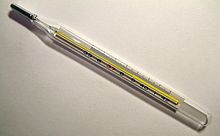
Back نوبة حموية Arabic Febril tutmalar Azerbaijani Febrilni epilepsijski napad BS Atafaeliad twymynol Welsh Fieberkrampf German Convulsión febril Spanish تشنج ناشی از تب Persian Kuumekouristus Finnish Convulsion hyperthermique French פרכוס חום HE
| Febrile seizure | |
|---|---|
| Other names | Fever fit, febrile convulsion |
 | |
| An analog medical thermometer showing a temperature of 38.8 °C or 101.8 °F | |
| Specialty | Emergency medicine, neurology |
| Symptoms | Tonic-clonic seizure[1] |
| Usual onset | Ages of 6 months to 5 years[1] |
| Duration | Typically less than 5 minutes[1] |
| Types | Simple, complex[1] |
| Causes | High body temperature[1] |
| Risk factors | Family history[1] |
| Differential diagnosis | Meningitis, metabolic disorders[1] |
| Treatment | Supportive care[1] |
| Medication | Benzodiazepines (rarely needed)[1] |
| Prognosis | Good[1] |
| Frequency | ~5% of children[2] |
A febrile seizure, also known as a fever fit or febrile convulsion, is a seizure associated with a high body temperature but without any serious underlying health issue.[1] They most commonly occur in children between the ages of 6 months and 5 years.[1][3] Most seizures are less than five minutes in duration, and the child is completely back to normal within an hour of the event.[1][4] There are two types: simple febrile seizures and complex febrile seizures.[1] Simple febrile seizures involve an otherwise healthy child who has at most one tonic-clonic seizure lasting less than 15 minutes in a 24-hour period.[1] Complex febrile seizures have focal symptoms, last longer than 15 minutes, or occur more than once within 24 hours.[5] About 80% are classified as simple febrile seizures.[6]
Febrile seizures are triggered by fever, typically due to a viral infection.[6] They may run in families.[1] The underlying mechanism is not fully known, but it is thought to involve genetics, environmental factors, brain immaturity, and inflammatory mediators.[7][8][6] The diagnosis involves verifying that there is not an infection of the brain, there are no metabolic problems, and there have not been prior seizures that have occurred without a fever.[1][6] Blood testing, imaging of the brain, or an electroencephalogram (EEG) is typically not needed.[1] Examination to determine the source of the fever is recommended.[1][6] In otherwise healthy-looking children a lumbar puncture is not necessarily required.[1]
Neither anti-seizure medication nor anti-fever medication are recommended in an effort to prevent further simple febrile seizures.[1][9] In the few cases that last greater than 5 minutes, a benzodiazepine such as lorazepam or midazolam may be used.[1][10] Efforts to rapidly cool during a seizure is not recommended.[11]
Febrile seizures affect 2–10% of children.[2] They are more common in boys than girls.[12] After a single febrile seizure there is an approximately 35% chance of having another one during childhood.[6] Outcomes are generally excellent with similar academic achievements to other children and no change in the risk of death for those with simple seizures.[1] There is tentative evidence that affected children have a slightly increased risk of epilepsy at 2% compared to the general population.[1]
- ^ a b c d e f g h i j k l m n o p q r s t u v w x Graves RC, Oehler K, Tingle LE (January 2012). "Febrile seizures: risks, evaluation, and prognosis". American Family Physician. 85 (2): 149–53. PMID 22335215.
- ^ a b Gupta A (February 2016). "Febrile Seizures". Continuum (Minneapolis, Minn.). 22 (1 Epilepsy): 51–9. doi:10.1212/CON.0000000000000274. PMID 26844730. S2CID 33033538.
- ^ Cite error: The named reference
Stat2019was invoked but never defined (see the help page). - ^ "Symptoms of febrile seizures". www.nhs.uk. 1 October 2012. Archived from the original on 6 October 2014. Retrieved 13 October 2014.
- ^ Cite error: The named reference
AAP2017was invoked but never defined (see the help page). - ^ a b c d e f Cite error: The named reference
Leu2018was invoked but never defined (see the help page). - ^ Cite error: The named reference
BMJ2015was invoked but never defined (see the help page). - ^ Cite error: The named reference
Kwon2018was invoked but never defined (see the help page). - ^ Offringa M, Newton R, Nevitt SJ, Vraka K (16 June 2021). "Prophylactic drug management for febrile seizures in children". The Cochrane Database of Systematic Reviews. 2021 (6): CD003031. doi:10.1002/14651858.CD003031.pub4. ISSN 1469-493X. PMC 8207248. PMID 34131913.
- ^ Prasad P (2013). Pocket Pediatrics: The Massachusetts General Hospital for Children Handbook of Pediatrics. Lippincott Williams & Wilkins. p. 419. ISBN 9781469830094. Archived from the original on 6 September 2017.
- ^ "Febrile Seizures". familydoctor.org. Retrieved 24 January 2020.
- ^ Ronald M. Perkin, ed. (2008). Pediatric hospital medicine : textbook of inpatient management (2nd ed.). Philadelphia: Wolters Kluwer Health/Lippincott Williams & Wilkins. p. 266. ISBN 9780781770323. Archived from the original on 6 September 2017.
© MMXXIII Rich X Search. We shall prevail. All rights reserved. Rich X Search